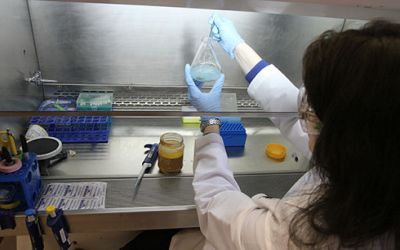Researchers Find Salmonella to be More Resilient Than Originally Thought
Virginia Tech scientists have provided new evidence that biofilms bacteria that adhere to surfaces and build protective coatings are at work in the survival of the human pathogen Salmonella.


Monica Ponder processes peanut butter through a simulated gastrointestinal system. Courtesy of Virginia Tech.
Â
Virginia Tech scientists have provided new evidence that biofilms bacteria that adhere to surfaces and build protective coatings are at work in the survival of the human pathogen Salmonella.
One out of every six Americans becomes ill from eating contaminated food each year, with over a million illnesses caused by Salmonella bacteria, according to the Centers for Disease Control and Prevention. Finding out what makes Salmonella resistant to antibacterial measures could help curb outbreaks.
Researchers affiliated with the Fralin Life Science Institute discovered that in addition to protecting Salmonella from heat-processing and sanitizers such as bleach, biofilms preserve the bacteria in extremely dry conditions, and again when the bacteria are subjected to normal digestive processes. The study is now online in the International Journal of Food Microbiology and will appear in the April issue.
Biofilms are an increasing problem in food processing plants serving as a potential source of contamination, says Monica Ponder, an assistant professor of food science and technology in the College of Agriculture and Life Sciences. We have discovered that Salmonella in biofilms survive on dried foods much better than previously thought, and because of this are more likely to cause disease, said Ponder.
Outbreaks of Salmonella associated with dried foods such as nuts, cereals, spices, powdered milk and pet foods have been associated with over 900 illnesses in the last five years. These foods were previously thought to be safe because the dry nature of the product stops microbial growth.
Most people expect to find Salmonella on raw meats but don't consider that it can survive on fruits, vegetables or dry products, which are not always cooked, says Ponder.
In moist conditions, Salmonella thrive and reproduce abundantly. If thrust into a dry environment, they cease to reproduce, but turn on genes which produce a biofilm, protecting them from the detrimental environment.Â
Researchers tested the resilience of the Salmonella biofilm by drying it and storing it in dry milk powder for up to 30 days. At various points it was tested in a simulated gastrointestinal system. Salmonella survived this long- term storage in large numbers but the biofilm Salmonella were more resilient than the free-floating cells treated to the same conditions.
The bacterias stress response to the dry conditions also made it more likely to cause disease. Biofilms allowed the Salmonella to survive the harsh, acidic environment of the stomach, increasing its chances of reaching the intestines, where infection results in the symptoms associated with food poisoning.
This research may help shape Food and Drug Administrations regulations by highlighting the need for better sanitation and new strategies to reduce biofilm formation on equipment, thus hopefully decreasing the likelihood of another outbreak.
Source: Virginia Tech
The Sterile Processing Conference Survival Guide: How to Make the Most of Your Next Event
March 25th 2025From expert speakers to cutting-edge tools, sterile processing conferences, like the 2025 HSPA Annual Conference and the SoCal SPA's Spring Conference, offer unmatched opportunities to grow your skills, expand your network, and strengthen your department's infection prevention game.
Redefining Material Compatibility in Sterilization: Insights From AAMI TIR17:2024
March 24th 2025AAMI TIR17:2024 provides updated, evidence-based guidance on material compatibility with sterilization modalities. It offers essential insights for medical device design and ensures safety without compromising functionality.